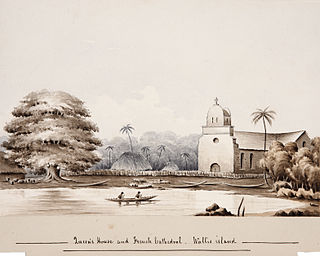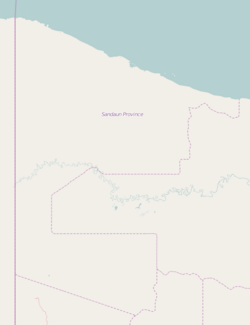
Oceania is a geographical region that is described as a continent in some parts of the world. It includes Australasia, Melanesia, Micronesia, and Polynesia. Spanning the Eastern and Western Hemispheres, Oceania is estimated to have a land area of 8,525,989 square kilometres (3,291,903 sq mi) and a population of around 44.4 million as of 2022. Oceania is described as a geographical region in most of the English-speaking world, but outside of the English-speaking world, Oceania is described as one of the continents. In this model of the world, Australia is only seen as an island nation contained inside of the continent of Oceania, and not a continent by itself. When compared to the other continents, Oceania is the smallest in land area and the second least populated after Antarctica.

Pacific Islanders, Pasifika, Pasefika, Pacificans or rarely Pacificers are the peoples of the Pacific Islands. As an ethnic/racial term, it is used to describe the original peoples—inhabitants and diasporas—of any of the three major subregions of Oceania.
Kokoda is a station town in the Oro Province of Papua New Guinea. It is famous as the northern end of the Kokoda Track, site of the eponymous Kokoda Track campaign of World War II. In that campaign, it had strategic significance because it had the only airfield along the Track. In the decades preceding, it had been a foothills settlement near the gold fields.
Tabubil is a town located in the Star Mountains area of the North Fly District of Western Province, Papua New Guinea. The town, including the adjoining relocated village of Wangabin and the industrial area of Laydown, is the largest settlement in the province, although the provincial capital, Daru is a similar size. It had a recorded population of 10,270 at the 2011 census.

In early 1942, elements of the Imperial Japanese Navy (IJN) proposed an invasion of mainland Australia. This proposal was opposed by the Imperial Japanese Army and Prime Minister Hideki Tojo, who regarded it as being unfeasible, given Australia's geography and the strength of the Allied defences. Instead, the Japanese military adopted a strategy of isolating mainland Australia from the United States by advancing through the South Pacific. This offensive was abandoned following the Battle of the Coral Sea and the Battle of Midway in May and June 1942, and all subsequent Japanese operations in the vicinity of Australia were undertaken to slow the advance of Allied forces.

The Telefomin cuscus is a critically endangered possum found on New Guinea.

Cathedral of Our Lady of the Assumption, also known as Matâ'Utu Cathedral, is a Roman Catholic cathedral, and a national monument of France, located in the town of Mata Utu on Uvea, in Wallis and Futuna. It is a dominant edifice in downtown Mata-Utu town, capital of Wallis Island. It bears the royal insignia of Wallis, a Maltese cross between its towers. The cathedral is also known as the "Our Lady of Good Hope Cathedral". It is the seat of Bishop Susitino Sionepoe.

This page is a list of districts of Papua New Guinea.

The New Guinea Highlands, also known as the Central Range or Central Cordillera, is a long chain of mountain ranges on the island of New Guinea, including the island's tallest peak, Puncak Jaya, Indonesia, 16,024 ft (4,884 m), the highest mountain in Oceania. The range is home to many intermountain river valleys, many of which support thriving agricultural communities. The highlands run generally east-west the length of the island, which is divided politically between Indonesia in the west and Papua New Guinea in the east.
The Koiarian languages Koiari are a small family of Trans–New Guinea languages spoken in the "Bird's Tail" of New Guinea. They are classified within the Southeast Papuan branch of Trans–New Guinea.
The Urapmin people are an ethnic group numbering about 375 people in the Telefomin District of the West Sepik Province of Papua New Guinea. One of the Min peoples who inhabit this area, the Urapmin share the common Min practices of hunter-gatherer subsistence, taro cultivation, and formerly, an elaborate secret cult available only to initiated men.

Honiara is the capital and largest city of Solomon Islands, situated on the northwestern coast of Guadalcanal. As of 2021, it had a population of 92,344 people. The city is served by Honiara International Airport and the seaport of Point Cruz, and lies along the Kukum Highway.
Telefomin District is a district of Sandaun Province of Papua New Guinea. Its capital is Telefomin. Its inhabitants include the Mountain Ok people, a cultural group with numerous sub-groups including the Telefol, the Urapmin, and the Wopkaimin. The Oksapmin also live in this district. Notable ethnographic research by Geoffrey B. Saxe at UC Berkeley has documented the encounter between pre-contact uses of number and its cultural evolution under conditions of monetization and exposure to schooling and the formal economy among the Oksapmin.

The Sepik is the longest river on the island of New Guinea, and the second largest in Oceania by discharge volume after the Fly River. The majority of the river flows through the Papua New Guinea (PNG) provinces of Sandaun and East Sepik, with a small section flowing through the Indonesian province of Papua.
Niue Hotel was a hotel in Niue, Oceania, the largest on the island. The government-owned hotel was built in 1975 in the hope of stimulating tourism. It was badly damaged in 1990, but was refurbished and expanded. However, it struggled to attract guests and in 2000 was put up for sale and leased for use as a medical school. The buildings were destroyed by a hurricane in 2004.

The Papuan scrub robin or New Guinea scrub robin is a species of bird in the family Petroicidae. It was found to be genetically distinct from the northern scrub robin, with which it was formerly considered conspecific.
Tula is a village in the Eastern District of Tutuila Island in American Samoa. Tula is located in Vaifanua County and had a population of 405 as of the 2010 U.S. Census.
Ottoville is a subdivision or district within the village of Tafuna, American Samoa.











